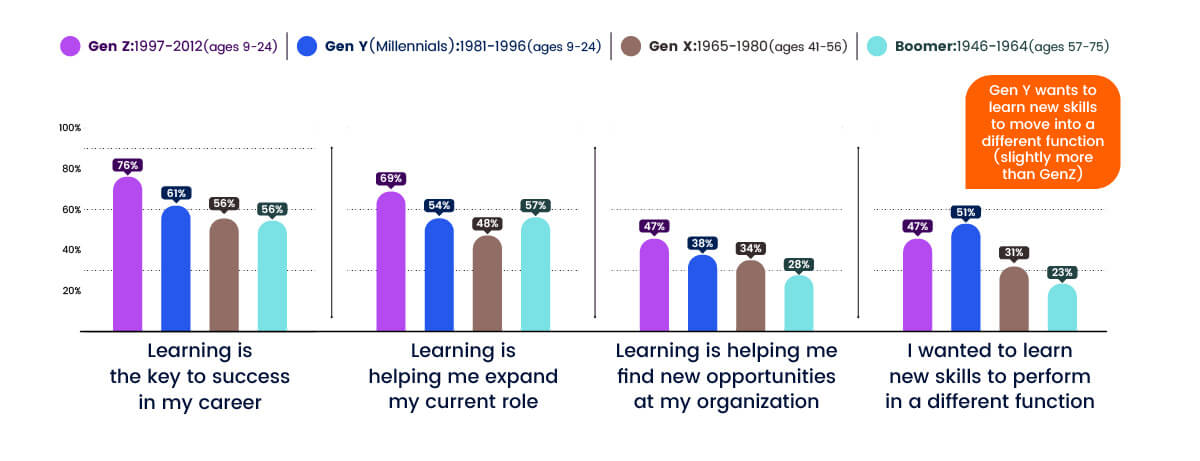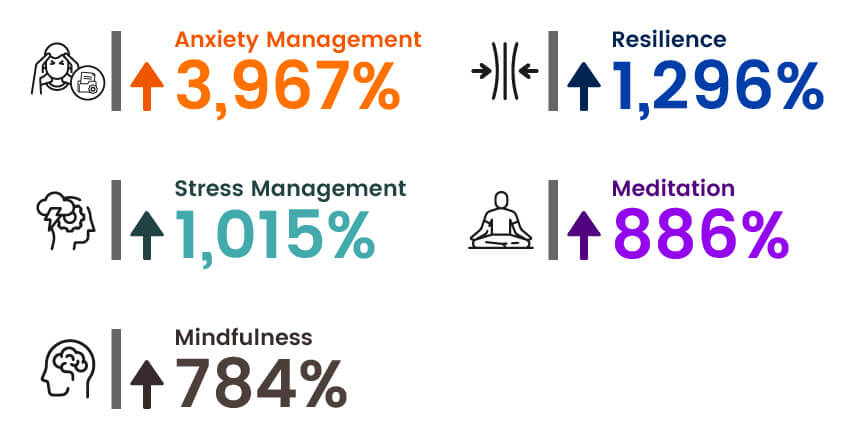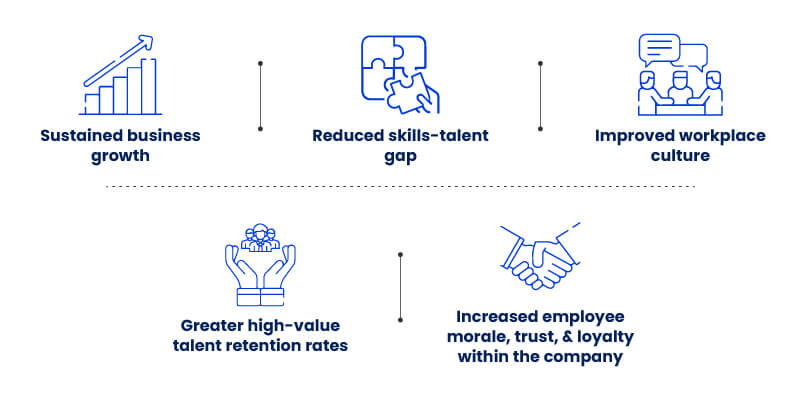Why Prioritizing Learning and Development in HR is Key to Employee and Organizational Success
The role of learning and development in HR is now more critical than ever.
The HR manager's primary responsibility is no longer restricted to scouting for
talent and hiring the right people. They have to focus on

- ensuring that the employees stay engaged with the organization,
- conducting employee evaluation,
- filling the learning gaps,
- creating employee-centric learning solutions,
- determining how they can drive employee performance, and
- helping employees climb the success ladder and achieve their career goals.
So, the real question is understanding how L&D and HR are intricately woven together.
Here's a table that summarizes the individual differences and the "connect" between both
of these disciplines by way of a few everyday use-cases:

Moving on, let's understand why HR needs to prioritize learning and development initiatives in today's ever-evolving workplace.
-
Gen Z is learning-obsessed and is demanding newer opportunities to learn:
Gen Z employees care about career growth.
 With 76% of Gen Z participants being more learning-focused and 69% making efforts
to carve out more time to learn, as reported by the LinkedIn survey, HR departments
need to laser-focus on an employee's succession planning if they want to retain the
best talent. The same survey predicted that Gen Z learners watched 50% more hours of
learning content per learner in 2020 vs. 2019. Another LinkedIn survey conducted in
2019 claims that a staggering 94% of employees would stay at a company longer if
there was an investment in their learning and development. So if companies are not
presenting employees with opportunities for learning and development, they are
literally showing employees the door.
With 76% of Gen Z participants being more learning-focused and 69% making efforts
to carve out more time to learn, as reported by the LinkedIn survey, HR departments
need to laser-focus on an employee's succession planning if they want to retain the
best talent. The same survey predicted that Gen Z learners watched 50% more hours of
learning content per learner in 2020 vs. 2019. Another LinkedIn survey conducted in
2019 claims that a staggering 94% of employees would stay at a company longer if
there was an investment in their learning and development. So if companies are not
presenting employees with opportunities for learning and development, they are
literally showing employees the door.
-
Value-driven L&D programs can keep the employees engaged and promote strong mental health:
Strategically conceived L&D programs can help build employee resilience and manage anxiety in the
workplace—a major concern for 91% of respondents who believe that a company's culture should support
mental health. Furthermore, the World Health Organization reported that depression and anxiety disorders
cost the global economy $1 trillion each year in lost productivity. Another report by Nespresso claims
that the Gen Y (98%), Gen X (99%), and Boomers (99%) surveyed believed that employee wellbeing and mental
health were of utmost importance. Needless to say, HR managers should integrate wellness programs into
the L&D infrastructure by:
- Providing regular training sessions with experts.
- Curating meaningful mental health programs that are aligned with the employees' personal and professional development goals.
- Building modules on work-related stress management with the help of experts and consultants.
- Curating an updated list of mental wellness courses for employees.
In fact, organizations such as Starbucks and Unilever are alreadyprioritizing the mental health
of their workforce. Additionally, a recent Udemy report claims that there's a four-digit
percentage increase in consumption of content related to anxiety management, stress management,
and resilience skills:

-
Skill-building offers wide-ranging benefits for the organization: Investing
in an L&D program offers 360-degree benefits that go beyond improving employee
performance. According to a McKinsey report,71-90% of respondents claim that skill
transformations have had a positive impact on four company outcomes: the ability to
realize company strategy, employees' performance, employee satisfaction, and reputation
as an employer. From the organization's perspective, the benefits of supporting the
employees' skill building in a programmatic way include:
-
Saved hiring costs: The disadvantages of employee turnover need no introduction. According to the Employee Benefit News, employers end up spending an average of 33% of a worker's annual salary to replace just one employee. The math is simple. Retaining employees is more profitable for a company's bottom line than hiring new employees. By extension, HR managers should place emphasis on driving engaging and relevant learning experiences to arm employees with new skills, help them engage in internal mobility within the company, and fuel the employees' appetite for learning.
-
Increased profits: According to the Harvard Business Review, developing an employees' strengths can offer the following advantages:
- 10%-19% increase in sales
- 14%-29% increase in profit
- 3%-7% increase in customer engagement
- 9%-15% increase in engaged employees
- 6- to 16-point decrease in turnover (in low-turnover organizations)
- 26- to 72-point decrease in turnover (in high-turnover organizations)
- 22%-59% decrease in safety incidents
-
Competitive edge: Research by the WEF states that 50% of all employees will need to be reskilled by 2025. The moral of the story? If organizations do not focus on reskilling/upskilling their employees, they are at a decided disadvantage. In simpler words, they can lose their competitive edge that stems from an outdated workforce. For L&D professionals and HR managers, the need of the hour is to identify the current and future skills gap and work towards curating an end-to-end learning and development framework.
In Summary: HR leaders need to view talent as a "renewable resource" and leverage
L&D as the primary asset to attract and retain employees. Furthermore, it is clear that the key
to a Gen Z worker's heart is career growth. Why HR leaders should invest in training and
development efforts to reap significant benefits such as:
- Sustained business growth
- Reduced skills-talent gap
- Greater high-value talent retention rates
- Improved workplace culture
- Increased employee morale, trust, and loyalty within the company

Learning and development in HR can offer tangible and intangible benefits for the organization
and employees alike. HR managers that do not engage in succession planning and prioritize
employee-centric career growth will miss out on promoting high-quality talent for future
organizational goals—a fatal mistake in today's cut-throat landscape.





 With 76% of Gen Z participants being more learning-focused and 69% making efforts
to carve out more time to learn, as reported by the LinkedIn survey, HR departments
need to laser-focus on an employee's succession planning if they want to retain the
best talent. The same survey predicted that Gen Z learners watched 50% more hours of
learning content per learner in 2020 vs. 2019. Another LinkedIn survey conducted in
2019 claims that a staggering 94% of employees would stay at a company longer if
there was an investment in their learning and development. So if companies are not
presenting employees with opportunities for learning and development, they are
literally showing employees the door.
With 76% of Gen Z participants being more learning-focused and 69% making efforts
to carve out more time to learn, as reported by the LinkedIn survey, HR departments
need to laser-focus on an employee's succession planning if they want to retain the
best talent. The same survey predicted that Gen Z learners watched 50% more hours of
learning content per learner in 2020 vs. 2019. Another LinkedIn survey conducted in
2019 claims that a staggering 94% of employees would stay at a company longer if
there was an investment in their learning and development. So if companies are not
presenting employees with opportunities for learning and development, they are
literally showing employees the door.


